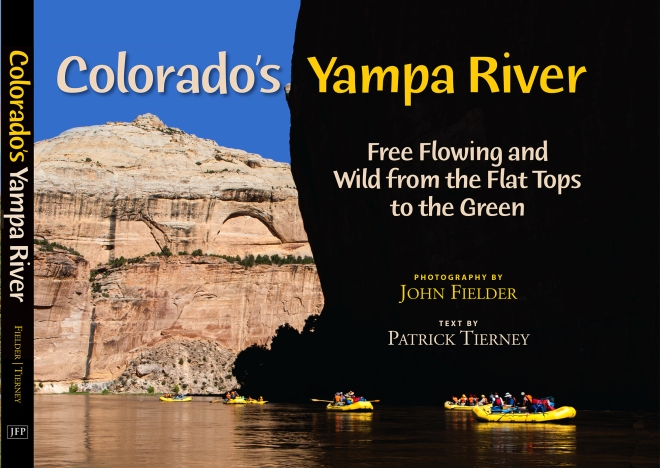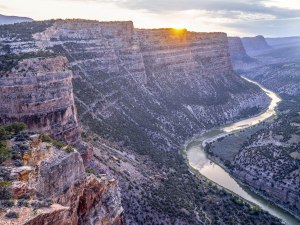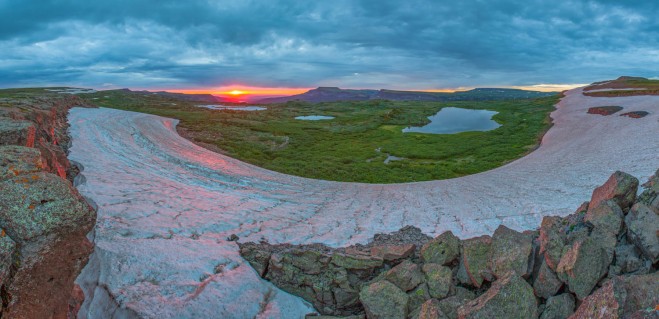 Grab a drink, relax and get ready to enjoy some magnificent Colorado splendor in this latest release from Colorado photographer John Fielder. “Colorado’s Yampa River, Free Flowing and Wild from the Flat Tops to the Green” transports you to the state’s northwest corner, home of the last major free-flowing river in the American Southwest’s Colorado River system: the Yampa.
Grab a drink, relax and get ready to enjoy some magnificent Colorado splendor in this latest release from Colorado photographer John Fielder. “Colorado’s Yampa River, Free Flowing and Wild from the Flat Tops to the Green” transports you to the state’s northwest corner, home of the last major free-flowing river in the American Southwest’s Colorado River system: the Yampa.
Together with author Patrick Tierney, a long-time student of the Yampa River in capacities ranging from river ranger and guide to researcher and former director of the Yampa River Awareness Project, Fielder leads readers on a 249-mile journey from the Yampa’s headwaters to its confluence with the Green River in the heart of Dinosaur National Monument. Along the way, the river drops 6,000 feet. It first trickles through wildflower-laden meadows in the Flat Tops Wilderness, later carries tubers and kayakers through a whitewater park in downtown Steamboat Springs, then begins gathering force as it meanders through vast agricultural plains, and finally winds into the desert slickrock landscape of Dinosaur National Monument where it continues its tens-of-thousands-year-old practice of carving the 2,500-foot-deep Yampa Canyon. The authors recount harrowing experiences with thunderstorms in the high country and bridges at high water as well as awe-inspiring encounters with upside-down rainbows and soaring peregrine falcons. Around 150 of Fielder’s photographs and then-and-now images grace the pages.
By exposing readers who may have never ventured to this wilder corner of the state or encountered this rare gem of a river, the authors hope to generate appreciation and concern for what, in today’s world, is a dying species: the untamed river. Except for a few small diversions and storage reservoirs high in the watershed, the Yampa flows each season with nearly the full force of its natural runoff. Tierney writes that “it’s the flow” that is so crucial to maintaining the Yampa’s unique bio-physical system, which sustains both rare and endangered species as well as local economies along its course.
But even more than scientific reasons for protecting the Yampa’s flow, Tierney suggests readers experience the river for themselves. He writes in an excerpted passage: “Data is helpful, computers useful, reports required, and legal briefs necessary, but these will only give a limited perspective of what the Yampa River truly is and why its life-giving peak flows and lush riparian corridors should be protected.To fully appreciate the natural treasure called the Yampa River, you must take a few days and feel its power, get splashed, smell its aromas, hear the call of a sandhill crane from its wetlands, touch its rocky foundation, observe its remote reaches, and let the river—its riparian richness and million-year-old canyon walls—put you under their spell.”
The Yampa River Awareness Project, run by the Steamboat-based nonprofit Friends of the Yampa, is an attempt to do just that by introducing new policymakers, water managers, nonprofit employees and journalists to the river every year through an annual float trip. This year’s trip included individuals from organizations that ran the gamut from water providers to energy companies to the governor’s office. Last year, both Fielder and Tierney were in attendance. While Fielder wandered off to scout each amazing new photograph, some of which appear in the book, Tierney was leading discussions on river protection mechanisms and imparting his vast store of Yampa River experience to the group.
I was fortunate to be along on that trip and to be at the receiving end of Tierney’s passionate storytelling and knowledge sharing. It was also the first time I met Fielder, though he has been an active member and supporter of the Colorado Foundation for Water Education for years. One thing led to the next, and I became part of the book project myself, serving as its editor outside of my role at CFWE. I’m thrilled to now hold the product of Fielder and Tierney’s hard work, as well as a bit of my own, in my hands and welcome the opportunity CFWE will have to help share it in our community as part of the ongoing discourse surrounding Colorado’s Water Plan and the tradeoffs inherent in our future. (The plan’s second draft was just released today, and can now be viewed and commented on online. Final comments are due by September 17, 2015.)
With the book hitting stores last week, Fielder and Tierney hope it will find its way into the hands of anyone from the general public to decision makers in the water arena. Says Fielder, “We hope that people who view and read the book will agree with Pat and I that Colorado and the West will be far better off ecologically and economically if Yampa River water remains within its banks. We encourage them to express this opinion to the Colorado Water Conservation Board via www.coloradowaterplan.org.”



 Print
Print
Reblogged this on Coyote Gulch.